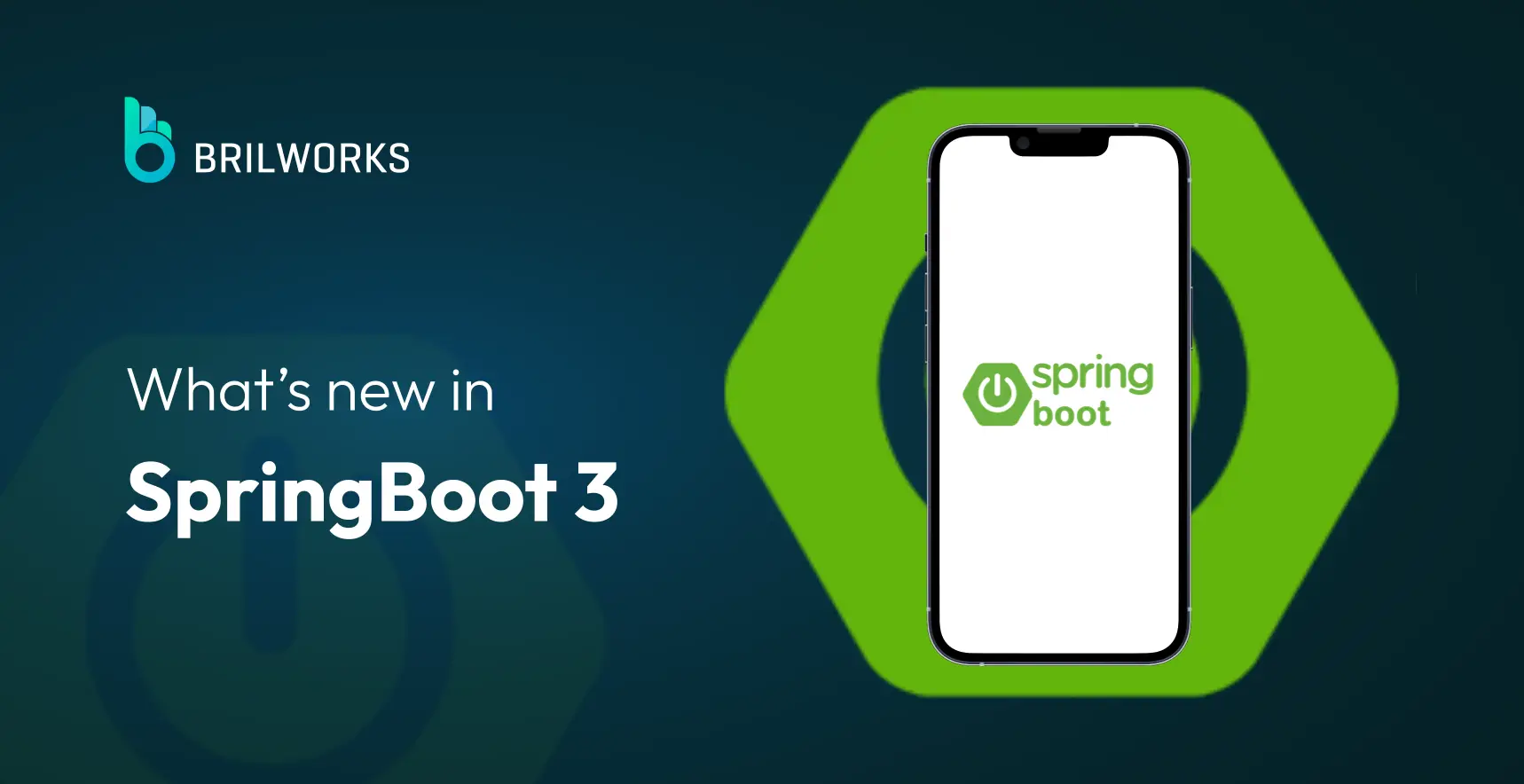COOPERATION MODEL
ARTIFICIAL INTELLIGENCE
PRODUCT ENGINEERING
DevOps & Cloud
LOW-CODE/NO-CODE DEVELOPMENT
INDUSTRY
FRONTEND DEVELOPMENT
CLOUD DEVELOPMENT
MOBILE APP DEVELOPMENT
LOW CODE/ NO CODE DEVELOPMENT
EMERGING TECHNOLOGIES








If you're working with Java and web applications, Spring Boot is the latest extension to the Spring Framework. Using Spring Boot, you can more easily develop production-ready web applications, and in significantly less time than you'd take otherwise. This powerful framework simplifies the process of creating a spring boot application that is both robust and scalable. The latest version of Spring Boot is 3.4.3.
Spring Boot, a foundational building block of Java web development, builds upon the rock-solid structure of the Spring Framework. It has a reputation for its powerful features—including automatic configuration, starter dependencies, Spring Boot CLI, Actuator, and Spring Initializer—and these give Java developers the ability to create apps that are ready for production, fast.This robust platform also benefits from effective dependency management, ensuring that integrated libraries remain consistent and compatible during development. The Spring team has been releasing updates consistently ever since the landmark release of Spring Boot 3 in late 2022, with the latest version of Spring Boot, 3.4.3, hitting shelves on February 20, 2025.
This article delves into the advancements of the latest Spring Boot version, tracing its transformative journey from earlier iterations such as Spring Boot 2.x. It offers developers a comprehensive guide to understanding the new features, enhancements, and best practices essential to stay ahead.
Spring Boot is like this add-on to the Spring Framework, which is a Java framework itself. It makes things easier by simplifying the framework, but it doesn't take away any of its power. It solves problems that developers had with the original Spring, mainly that it's too complicated. That makes setting up applications and stuff difficult and time-consuming. Thankfully, with Spring Boot’s easy-to-use toolkit, Java developers can speed up development. Features like embedded servers, auto-configuration, and integrated Spring Data with seamless database access have made it a favorite for many programmers. Whether you’re developing a microservice or a full-fledged spring boot application, the flexibility and efficiency of the platform make it an excellent choice.
The newest Spring Boot version, 3.4.3, keeps the momentum going, delivering polished tools and features that fit perfectly with today’s development demands, whether you’re crafting microservices, building cloud-native apps, or tapping into Spring Data for data-heavy projects. Moreover, improved dependency management in this release streamlines updates and resolves compatibility issues, providing developers with a smoother integration process. So, let’s break down what’s fresh in this release and see how it stacks up against older versions like Spring Boot 2.x.
|
Feature/Capability |
Spring Boot 2.x |
Spring Boot 3.x (3.4.3) |
|
Java Version Support |
Java 8–17 |
Java 17–21 (with virtual thread support in Java 21) |
|
Virtual Threads |
Not supported |
Fully supported |
|
Observability |
Basic Micrometer integration |
Advanced Micrometer + OpenTelemetry |
|
Cloud-Native Support |
Limited Kubernetes integration |
Enhanced Kubernetes and serverless support |
|
Security |
Standard OAuth2 support |
Improved OAuth2 and OpenID Connect |
|
Spring Data Integration |
Standard repository support |
Enhanced repository and query capabilities |
|
Developer Tooling |
Basic CLI and IDE plugins |
Refined tools for faster development |
The Spring Boot 3 series, launched in November 2022, marked a significant shift with its adoption of Java 17 and Jakarta EE 9+. It introduced amazing features that are relevant to this day in the Spring Boot latest version, 3.4.3. Here’s a closer look at the foundational updates from Spring Boot 3, many of which have been enhanced in subsequent releases.
GraalVM, a high-performance runtime, enables faster execution of Java applications through Ahead-of-Time (AOT) and Just-in-Time (JIT) compilation. Spring Boot 3 brought native image support, allowing developers to compile applications into lightweight executables with reduced memory footprints and blazing-fast startup times. This is a game-changer for cloud deployments and microservices, where efficiency is paramount.
GraalVM has made Java apps even faster by making them execute quicker through its Ahead-of-Time (AOT) and Just-in-Time (JIT) compilation. Spring Boot 3 has added native image support. This means developers can compile their apps now into lightweight executables. GraalVM support is still essential in the latest Spring Boot version, 3.4.3, and the compatibility has been enhanced to GraalVM 22.3+.
Spring Boot 3 has some great updates, especially for Log4j2 logging, which is now the preferred logging framework. The updates you can look forward to include:
You can now make configuration changes specifically for each environment (e.g., dev, prod).
You can now automatically pull property configurations from your environment.
Developers can now make configuration changes specifically for each environment, such as development, production, and testing, and can also automatically pull property configurations from their environment. Spring Boot 3.4.3 builds on these improvements, which will give them the kind of seamless integration with modern logging needs that they crave. Before version 3.4.3, Log4j2 support was less flexible in Spring Boot 2.x, and these updates provide developers with more granular control.
Spring Boot 3 simplified constructor binding for @ConfigurationProperties classes. If a class has a single parameterized constructor, the @ConstructorBinding annotation is no longer required, reducing boilerplate code. For classes with multiple constructors, you still use @ConstructorBinding to specify the target. This change streamlines configuration management—a notable leap from Spring Boot 2.x’s more rigid approach.
In Spring Boot 3.4.3, this logic remains intact, making it easier to manage properties in complex applications, especially those integrating with Spring Data repositories.
Micrometer, Spring Boot’s go-to tool for application monitoring, received significant upgrades in Spring Boot 3. Key enhancements include:
Auto-configuration for the Micrometer Observation API.
Support for Micrometer Tracing with Brave and OpenTelemetry.
Integration with OtlpMeterRegistry for OpenTelemetry metrics.
Enhanced Prometheus support, including Exemplars and updated Push Gateway behavior (favoring POST over deprecated PUT).
The latest Spring Boot version, 3.4.3, refines these features, ensuring robust observability for modern applications. This is a stark contrast to Spring Boot 2.x, where monitoring capabilities were less comprehensive.
Spring Boot 3 introduced several smaller but impactful changes:
Auto-configuration for the Elasticsearch Java Client.
Support for JdkClientHttpConnector with Apache HTTP Client.
Enhanced @SpringBootTest flexibility, leveraging custom main method configurations.
These updates, carried forward into Spring Boot 3.4.3, showcase the framework’s commitment to evolving with developer needs.
The latest Spring Boot version, 3.4.3, builds on the 3.x series with a focus on stability, bug fixes, and dependency updates. Moreover, the enhanced dependency management in version 3.4.3 guarantees that all integrated libraries remain seamlessly compatible, significantly easing the upgrade process for developers. Released on February 20, 2025, it aligns with Spring Framework 6.2.3 and incorporates the latest from other Spring projects. Below, we explore the key updates introduced in Spring Boot 3.4 (November 2024) and refined in 3.4.3, ensuring developers have the most current tools at their disposal.
Introduced in Spring Boot 3.2 and enhanced in later releases, virtual thread support leverages JDK 21’s lightweight threading model. In Spring Boot 3.4.3, this feature is fully optimized, allowing applications to handle thousands of concurrent tasks with minimal overhead. Enable it with spring.threads.virtual.enabled=true for I/O-bound workloads like REST APIs or Spring Data queries. Compared to Spring Boot 2.x’s traditional threading model, this is a significant scalability boost.
Spring Boot 3.4 deepened its Docker Compose support, streamlining development with containerized dependencies like databases and message brokers. The latest Spring Boot version, 3.4.3, refines this integration, supporting Bitnami images and adding flexibility for tools like Redis Stack and Hazelcast. This is a leap forward from Spring Boot 2.x, where such native integration was absent.
Managing SSL certificates became easier with Spring Boot 3.4’s introduction of SSL bundles, which can reload automatically when trust material changes (opt-in via reload-on-update=true). In Spring Boot 3.4.3, this feature is stable and widely adopted, enhancing security for production apps—a capability unavailable in Spring Boot 2.x.
Observability remains a priority in the Spring Boot latest version, 3.4.3. Building on Micrometer and OpenTelemetry integrations, it offers:
Structured logging support for ECS, Logstash, and GELF formats.
Improved tracing for REST controllers and reactive applications.
Auto-configuration for OtlpTracingAutoConfiguration (replacing the deprecated OtlpAutoConfiguration).
These enhancements provide deeper insights into application behavior, far surpassing the monitoring options in Spring Boot 2.x.
Testing is critical, and Spring Boot 3.4.3 enhances Testcontainers support with:
Redis Stack integration via redis/redis-stack-server.
Hazelcast support for distributed testing.
Auto-configuration for MockMvcTester with AssertJ.
This builds on Spring Boot 3.1’s initial Testcontainers support, offering a more robust testing framework than Spring Boot 2.x.
The latest Spring Boot version, 3.4.3, integrates seamlessly with Spring Data 2024.0.3, bringing updates to modules like Spring Data JPA, MongoDB, and Redis. Key improvements include:
Better support for virtual threads in reactive repositories.
Enhanced connection details for external services like Cassandra and Neo4j.
Refined auto-configuration for Spring Data repositories.
These updates make data access more efficient compared to Spring Boot 2.x, where Spring Data lacked such modern integrations.
Spring Boot 3.4.3 includes critical dependency updates:
Spring Framework 6.2.3
Spring Data 2024.0.3
Spring Security 6.4.3
Tomcat 10.1.35
Hibernate ORM 6.2.3
These upgrades ensure compatibility with the latest ecosystem, fixing bugs and improving performance over earlier 3.x releases. Moreover, enhanced dependency management in Spring Boot 3.4.3 ensures that all updated libraries and frameworks work seamlessly together for optimal performance.
The latest Spring Boot version, 3.4.3, continues the cleanup of outdated features from Spring Boot 3.0 onward:
JsonMixinModule scanning-based constructor.
ClientHttpRequestFactorySupplier (replaced by ClientHttpRequestFactories).
Legacy metrics properties (management.metrics.export.<product>) in favor of management.<product>.metrics.export.
@AutoConfigureMetrics (replaced by @AutoConfigureObservability).
WebJars webjars-locator-core in favor of webjars-locator-lite.
These deprecations align Spring Boot with modern standards, contrasting with Spring Boot 2.x’s reliance on older APIs.
Since Spring Boot 3.4.3depends on Spring Framework 6, here are key updates from Spring 6.2.3 that impact the latest Spring Boot version:
JDK 17+ Baseline: Full support for Java 17+ features, with testing up to JDK 21.
Jakarta EE 9+: Transition to jakarta.* namespaces.
GraalVM Support: Comprehensive AOT processing for native images.
Observability: Native Micrometer Observation across MVC and WebFlux.
Spring Data Integration: Enhanced JPA and R2DBC support with Hibernate 6.2.3.
These updates ensure Spring Boot 3.4.3 remains cutting-edge, far beyond the capabilities of Spring Boot 2.x.
Upgrading to the latest Spring Boot version, 3.4.3, requires careful planning, especially if you’re coming from Spring Boot 2.x.
From Spring Boot 2.x: First upgrade to 2.7.x, the last 2.x release, to address deprecations and prepare for Java 17. Then migrate to 3.0.0, followed by incremental updates to 3.4.3. This stepwise approach minimizes compatibility issues.
From Spring Boot 3.x: If you’re on 3.0.x or later, update your dependencies to 3.4.3 using Maven or Gradle. Check the release Notes for specific changes.
JDK 17+: Spring Boot 3.4.3 requires at least Java 17, with support up to JDK 21.
GraalVM: Use GraalVM 22.3+ for native images, paired with Native Build Tools Plugin 0.9.20+.
Build Tools: Maven 3.6.3+ or Gradle 8.5+.
Update your pom.xml (Maven) or build.gradle (Gradle) to reference Spring Boot 3.4.3. This update ensures that your spring boot application benefits from the latest improvements in performance and security.
Resolve deprecated APIs and adjust configurations (e.g., @Validated behavior for @ConfigurationProperties).
Test thoroughly, leveraging Testcontainers and Spring Data enhancements.
Deploy and monitor using updated observability tools.
The Spring Boot Migration Guide provides detailed instructions.
Spring Boot 2.x, capped at 2.7.x, served developers well with Java 8/11 support and traditional Spring features. However, the latest Spring Boot version, 3.4.3, offers significant advantages:
Java Baseline: 2.x supports Java 8/11; 3.4.3 requires Java 17+.
Native Images: Absent in 2.x, fully supported in 3.4.3.
Observability: Basic in 2.x, advanced in 3.4.3 with Micrometer and OpenTelemetry.
Spring Data: 2.x lacks virtual thread support and modern integrations present in 3.4.3.
Scalability: Virtual threads in 3.4.3 outpace 2.x’s threading model.
For legacy projects, Spring Boot 2.x remains viable, but new projects should adopt 3.4.3 for future-proofing.
The latest Spring Boot version, 3.4.3, released on February 20, 2025, is a significant milestone for the framework. Packed with updates and new features, it stands as the most advanced and comprehensive version of Spring Boot yet. If you're thinking about upgrading, here are a few reasons why 3.4.3 is worth the leap:
Whether you're migrating from Spring Boot 2.x or upgrading within the 3.x series, this version introduces tools designed to simplify workflows and enhance productivity. With features like virtual thread support, improved Spring Data integration, and stronger observability, it equips developers to build more efficient and scalable applications.
If your team is looking to fully leverage the capabilities of Spring Boot 3.4.3, consider reaching out to Brilworks. They provide experienced Spring developers on a full-time, contractual, or dedicated basis, ensuring your projects make the most of this powerful release and beyond.
We hope this article has provided you with enough information to decide whether you should upgrade to the latest version of Spring Boot or wait. To keep up-to-date with the latest advancements in Java web development, make sure to continue reading our blogs for updates and guides on recent developments in the field.
If you are looking to hire a Spring developer. In that case, it is essential to choose a provider offering seasoned professionals with extensive knowledge of the Spring framework and its related technologies.
To this end, at Brilworks, we provide Java application development services with a Spring developer on a full-time, contractual, or dedicated basis.
Spring Boot 3's integration with GraalVM native image support allows you to create self-contained executables for your applications. These executables start up much faster and have a smaller memory footprint compared to traditional deployments. This can be especially beneficial for microservices and cloud-native deployments where rapid startup times and efficient resource utilization are crucial. Upgrading to Spring Boot 3.4.3 offers benefits like virtual thread support for better concurrency, enhanced observability for easier debugging, and improved cloud-native capabilities for modern application deployment.
While Spring Boot 3.4.3 introduces many new features, some breaking changes may require code adjustments when migrating from 2.x. However, detailed migration guides are available to ease the transition.
With virtual thread support, optimized Spring Data integration, and advanced observability tools, Spring Boot 3.4.3 significantly boosts application performance and scalability.
No, Spring Boot 3.4.3 requires Java 17 or higher, with additional features like virtual threads available in Java 21.
Spring provides migration guides, and companies like Brilworks offer expert Spring developers to assist with upgrades and ensure a smooth transition.
Absolutely! Spring Boot 3.4.3’s cloud-native enhancements, observability features, and virtual thread support make it an excellent choice for building and scaling microservices.
Get In Touch
Contact us for your software development requirements
Get In Touch
Contact us for your software development requirements